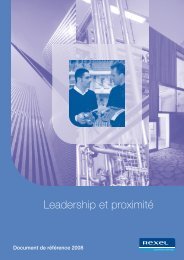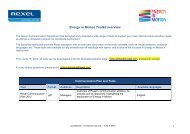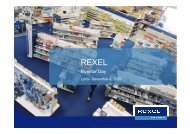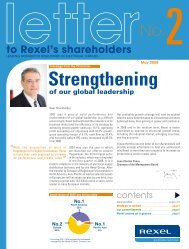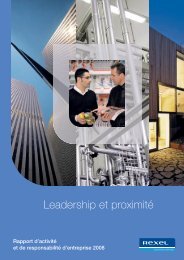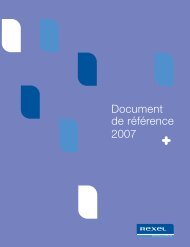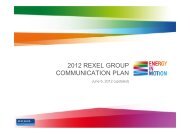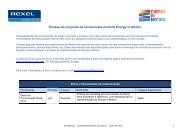2008 Registration Document - Rexel
2008 Registration Document - Rexel
2008 Registration Document - Rexel
You also want an ePaper? Increase the reach of your titles
YUMPU automatically turns print PDFs into web optimized ePapers that Google loves.
Annex 12. Implemented internal control procedures2.1 Group approach2.1.1 Definition and purposes of internal controlThe methods adopted by the Group are based on the COSO(Committee of Sponsoring Organizations of the TreadwayCommission) standard. In addition, the Audit Departmentensured that the standards of the AMF’s Groupe de Placeare taken into account by the Group’s internal controlprocedures and guidelines.The Group considers internal control as an ongoingprocess, which seeks to ensure:− compliance with laws and regulations;− implementation of the instructions and orientations set byGeneral Management;− the proper functioning of internal working processes, inparticular those relating to the safeguarding of assets;and− the reliability of financial information.As such, internal control contributes to risk management,transactional efficiency and the efficient use of Groupresources. However, as well conceived and applied as theymay be, these measures cannot absolutely guarantee theachievement of the Company’s objectives.2.1.2 Group structure and control of subsidiariesby the parent companyThe Group is organized by geographic zones. Each of thesezones is represented on the Group’s Executive Committeeby the President of the zone.Each zone consolidates its subsidiaries located in oneor more countries. The management within the zonesmonitors the subsidiaries and relays instructions andpolicies defined by the operational departments at theGroup’s headquarters.The internal control methods described below constitutea common standard, which must be applied by themanagement of the zones and their respective subsidiaries.Zone management is responsible for supplementing thesemethods with local procedures, as the case may be.These methods apply to all consolidated subsidiaries.Their implementation in recently acquired subsidiariesis progressively rolled out during the integration of thesubsidiary into the Group. However, considering thesize of the Hagemeyer acquisition, extensive resourceswere allocated to facilitate the prompt appropriation ofthe Company’s internal control methods at the entitiespreviously owned by Hagemeyer (see paragraph 2.3.5 ofthis report).2.2 Internal control principlesand participants2.2.1 PrinciplesThe Group’s branch network and subsidiaries form a partof a decentralized structure that relies on the responsibilityof local managers.In order to ensure a high level of process controls in itssubsidiaries, the Group issues a common standard,composed of control objectives and procedures withwhich local managers must conform their internal controlmethods.2.2.2 ParticipantsThe Management Board, through the Audit Committee,informs the Supervisory Board of the key characteristics ofthe internal control standard, its implementation within theGroup and the steps taken to improve this standard.The Executive Committee, which is made up of theManagement Board, certain executives of the Company andthe zone Presidents, meets every six weeks, on average.The Executive Committee is responsible for theimplementation of the objectives set by the ManagementBoard and ensures their application by the subsidiaries. TheCommittee monitors budget plans and other operationalaction plans, develops transverse projects and determinesobjectives in the area of human resources policy.The Finance, Control and Legal Department is organizedaround poles of responsibility: (i) finance-treasurycreditmanagement and real property management; (ii)consolidation, financial controls and tax; (iii) legal affairsand insurance; (iv) financial communication and sustainabledevelopment; and (v) audit and internal control.The Human Resources Department is responsible fordefining human resources management policy andprocedures and ethical standards, and monitors compliancewith labor regulations. The Department assists subsidiarieswith the allocation of resources and training (supervision ofthe <strong>Rexel</strong> Schools, executive career development).The Business Development Department is responsiblefor the Group’s strategy, external growth transactions,information systems, purchasing, logistics and marketing.The Department monitors, supervises and gets the principalprojects in its domain approved (as the case may be, by theInvestment Committee).These three Departments participate in defining andupdating the internal control standard. The implementationPAGE 274 | REXEL <strong>2008</strong>




